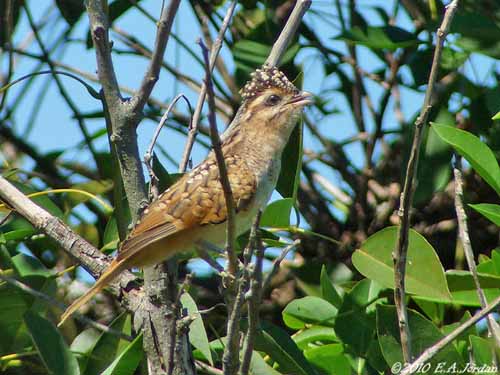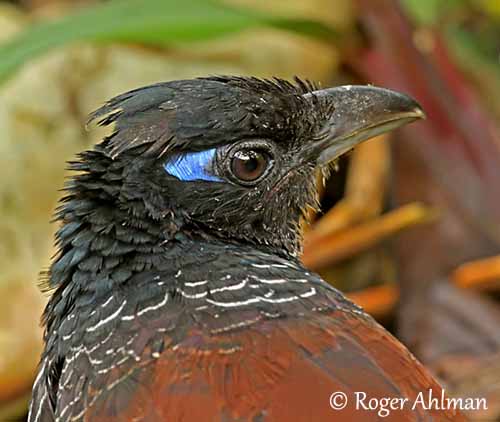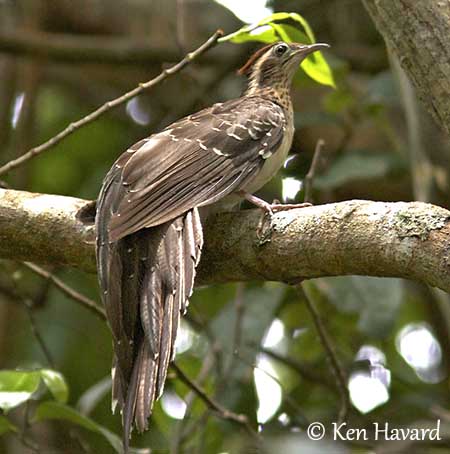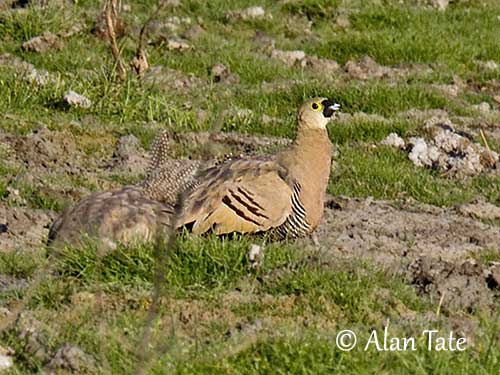
Page under
copyright !
TO BE CONTINUED... Page 11
Text by Nicole Bouglouan
Photographers:
Roger Ahlman
Pbase Galleries Peru and Ecuador & My bird pictures on IBC
Marc Chrétien
MURINUS
Alfredo Colón
Puerto Rico Wildlife
Maxime Dechelle
LEPAPARRAZO
Jean Michel Fenerole
Photos d’Oiseaux
Steve Garvie
RAINBIRDER Photo galleries & Flickr Rainbirder
Ken Havard
My Bird Gallery & Flickr gallery 1 & Flickr gallery 2
Patrick Ingremeau
TAMANDUA
Eduardo Andrés Jordan
MIS AVES – AVES DE ARGENTINA
Ian McHenry
My New Zealand Birds
Tom Merigan
Tom Merigan’s Photo Galleries
Eugène Montocchio
Galerie Photos Nature
Bob Moul
Nature Photography
William Price
PBase-tereksandpiper & Flickr William Price
Alan & Ann Tate
AA Bird Photography
Ingo Waschkies
Bird Photography
Callie de Wet
GALERIE
Philippe et Aline Wolfer
OISEAUX D'ARGENTINE
Nicole Bouglouan
Photographic ramble
These images and the text are subject to copyright and cannot be used without express authorization from the owners. Legal issues
Sources :
HANDBOOK OF THE BIRDS OF THE WORLD vol 4 by Josep del Hoyo-Andrew Elliott-Jordi Sargatal - Lynx Edicions - ISBN: 8487334229
L’ENCYCLOPEDIE MONDIALE DES OISEAUX - Dr Christopher M. Perrins - BORDAS - ISBN: 2040185607
PARROTS OF THE WORLD – An Identification Guide – by Joseph M. Forshaw – Princeton University Press – ISBN 0691092516
Wikipedia, the free encyclopaedia
Bird nests: Variety is Key for the world’s avian Architects
Be on the lookout for bird nests
The design and function of birds' nests
The bird and its nest, where everything starts…
Page 10: Pteroclidae, Columbidae, Cacatuidae, Psittacidae, Psittaculidae, Strigopidae, Musophagidae, Cuculidae
At the beginning of the breeding season and following several courtship displays, the nest-site is selected by the pair, or one of the members of the pair, and the nest is built within this area. For numerous species, the nest is the place where displays and copulation occur. It plays a very important role during the nesting period. It is the cradle of the chicks, the place where the adults feed them prior to their first flight towards independence.
The family Pteroclidae includes medium-sized terrestrial birds, fairly similar to partridges or pigeons. They can be found in Afrotropical, Palearctic and Oriental regions. They live in open areas, often in arid or semi-arid areas for which they are well-adapted.
In spite of short legs, they walk with short steps and are able to run fast if necessary. They can take off rapidly and the flight is strong and sustained, even over long distances.
The pale colour of their plumage is adapted to the habitat in which it blends easily. They feed primarily on seeds, but leaves, shoots and other plant matter are also taken.

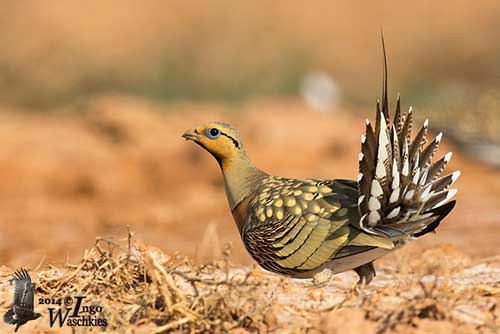
The sandgrouses are monogamous, and depending on the species, they breed in isolated pairs or loose colonies. They nest on the ground and both adults share the nesting duties.
The nest is a shallow scrape or existing hollow on the ground. Some species are known to nest in camel footprints in Iraq. Except for this case, some materials can be added, such as small stones or pieces of grass. The nests are sometimes in the open, but some others are close to vegetation, clump of grass, dry grass, rocks and stones.
The clutch consists normally of three eggs cryptically coloured. The male usually incubates at night, while the female incubates by day, because she has more cryptic plumage.

The chicks are precocial and can feed themselves when only one day old. They follow their parents which defend and protect them. They grow rapidly and fledge about three weeks after hatching. However, they depend on adults for water until they are at least two month old. The belly feathers of the adults, and especially those of the male, are adapted to carry water to the chicks.
Sandgrouses are very well adapted for breeding in arid areas where seeds are abundant, even if the water is far from their nests. This fact reduces the risk of predation and competition for food and water.
The Columbidae are mainly arboreal, often living among the foliage of the trees. Most of them feed on the ground, although some species also feed in trees. The typical characteristics of the members of this family include short bill, small head, short legs and compact body. The eyes are often surrounded by bare skin which colour varies according to the species. They have large flight muscles, reflecting their excellent flying availabilities. The wing shape of each species let us know if the bird is migratory or not.
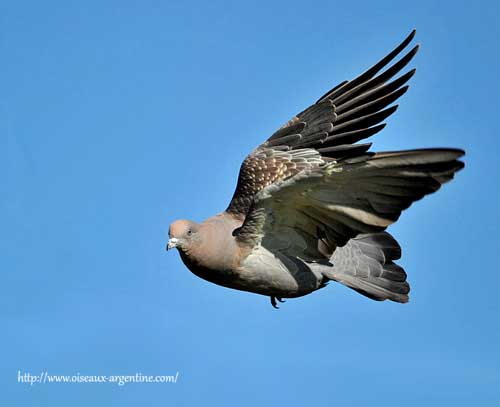
Pigeons and doves are living throughout the world except in Arctic and Antarctic regions. They frequent habitats from forest of all types to open country such as savannahs, deserts, high areas above the tree-line, cliff sides and coral atolls.
In Australia, several species are completely terrestrial. They live in a wide variety of habitats, showing how adaptable these birds are!
Depending on the species, they feed on seeds or fruits and berries, but many species also take insects, worms and small snails, often collected from the forest floor. Seeds are taken from the ground, whereas fruits are plucked directly from trees. Some arboreal species are able to cling to, hang for or clamber among branches.

They form monogamous bonds, at least for the breeding season. Several types of displays are performed by all species and associated to pair formation, nest building and defence.
The arboreal species gather nest material by breaking off dead twigs from trees or shrubs, while the terrestrial species collect the materials from the ground.
Usually, the male carries nest materials to the female which arranges them and builds the nest. The nest consists of a platform or a shallow cup made with twigs or dead stems of several plants. Such nest is a loose and flimsy structure and may dry out quickly after the rain. However, some nests are more “worked” such as in the Superb Fruit-doves (Ptilinopus superbus) which nest is made with sticks forked and intertwined together, giving a strong result. In the same way, the nest of the White-tipped Dove (Leptotila verreauxi) may be very bulky. The nests of the ground doves of genus Columbina are stronger than in other species.
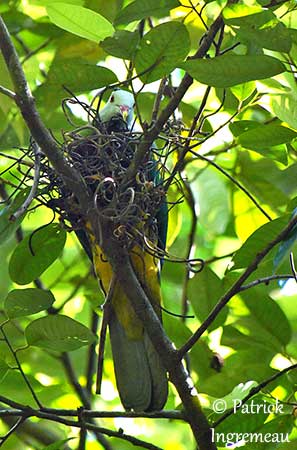
According to the species and the range, the nest may be placed in crevices in cliffs (Rock Dove and Snow Pigeon), while others nest in trees or on the ground (Spinifex Pigeon and Flock Bronzewing), in vegetation, among boulders or in holes. Most species nest solitary, but some of them nest colonially. The Nicobar Pigeon (Caloenas nicobarica) may form colonies of thousands of nests.
The chicks are fed with regurgitated crop-milk directly into the bill. The lower mandible is boat-shaped and broader than the upper, and used as receptacle. The chicks are dependent on parents during about 40 days after hatching, and adults continue to produce this peculiar food.

Adult feeding young
The large order Psittaciformes includes several races of parrots of different sizes and colours, but with almost similar behaviour throughout their wide range. Today, four families form this large order: Psittacidae, Cacatuidae, Psittaculidae and Strigopidae.
Their size and coloration are very variable. The largest parrot is the Hyacinth Macaw which reaches 100 centimetres long, but the male flightless Kakapo may weight up to 3 kg. The smallest species are the pygmy-parrots (genus Micropsitta) that are 8 centimetres long and weight as little as 10 grams.
Their plumage varies wildly, but the physical structure is more uniform. They are good fliers, including the sedentary species. They move easily in trees, grasping the branches with help of both claws and strong, hooked bill.
They usually live in forested habitats, but small numbers frequents more open areas. They are gregarious and often seen in large flocks, especially at roosting-sites.
Parrots feed primarily on plant matter such as seeds, fruits and flowers. Their strongly curved bill allows them to get the high nutritional content of hard seeds and nuts, often with help of one foot. They also take unripe fruits that contain toxic alkaloid substances.
For this reason, numerous parrot species gather at exposed banks of clay within the forest, especially in South America in Peru and Ecuador. See Parrots and clay… an old story!
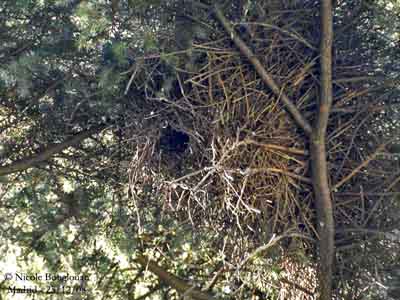
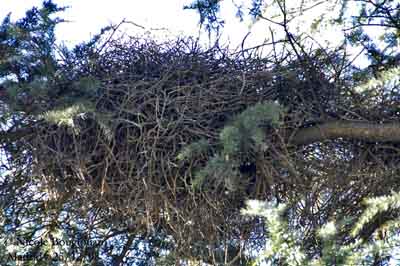

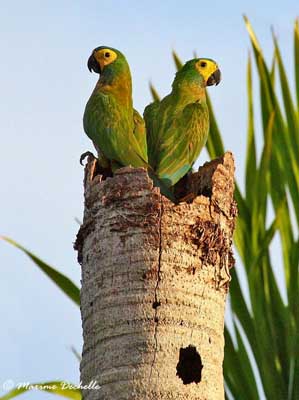
Parrots usually pair for life. They nest in holes and various cavities. They are monogamous, except for the Kea and the Kakapo that have different breeding system.
The nest-hole is carefully selected by the pair prior to the egg-laying. The nest may be prepared by the birds over several weeks, if the entrance needs widening or other work inside the hole, in order to make the cavity suitable for this period.
Some nests are excavated in arboreal termitaria, especially by lowland species of pygmy-parrots.
The New World species tend to use more holes in cliffs than the Old World species. The Burrowing Parakeet nests in colonies in cliff-faces. The nest is a burrow excavated in sandstone or earth cliff, often along river or sea and at considerable height.
This species is monogamous with long pair-bonds. They excavate the burrows which often are interconnecting. The established pairs usually reuse the same burrow every year, while the new pairs must excavate a new one.
There is a tunnel of about 80-250 centimetres long, often in a zigzag, opening into the nest-chamber where the eggs are laid and the chicks raised.
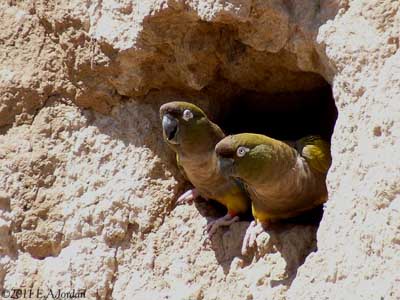
But the Monk Parakeet is the only member of this order which builds a nest in higher branches in trees, or any tall structure, natural or artificial. The nest is made with dry twigs, often thorny twigs for protection. It may nest colonially or solitary. These huge nests often attract many other species for nesting.
As cavity nesters, all parrots lay white eggs. The altricial chicks are fed by the female receiving food from the male. Prior to fledging, the young spend time perching at nest entrance. They become rapidly sexually mature.
The turacos of family Musophagidae are endemic to sub-Saharan Africa. They are medium-sized birds, except the Great Blue Turaco which is the largest. They have a rather long tail and short rounded wings. The head feathers have often a “hairy” texture, and almost all species show erectile crest. The short, strong bill has curved culmen.
Their flight is weak and laboured, but they move easily along branches and among the vegetation.
Most of turacos are arboreal and frequent all types of forest and woodland, but they especially favour lowland, gallery and montane forests.
They are vegetarian, and feed primarily on wild and cultivated fruits, and also foliage but to a lesser extent. Invertebrates such as caterpillars, moths, beetles, snails, slugs and termites are also part of their diet.

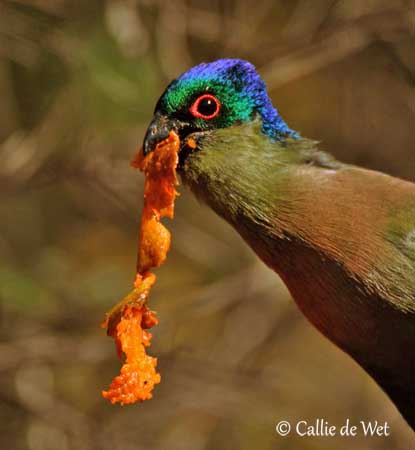
They are very territorial and usually remain in family groups for long periods, but most forest turacos can be seen in pairs and are territorial all year round. All species breed solitary and the pair defends the territory. They are usually monogamous, but some species may have helpers.
The nest is a flat, flimsy structure made with sticks and twigs, resembling the nests of Columbidae. The forest turacos build the nest among the thick foliage in trees or shrubs where it is well concealed, between 5 and 20 metres above the ground.
The chicks are fed by regurgitation. At 2-3 weeks, the young often leave the nest to clamber about in the nearby branches, long time before they can fly, that occurs usually 4-5 weeks after hatching.
The Cuculidae family includes six subfamilies, which differ both in appearance and behaviour.
The Cuculinae subfamily includes the Old World parasitic cuckoos. They usually frequent forests and woodlands, scrub and bushes, thorny scrub, deciduous and evergreen wooded areas, secondary forest, acacia thicket, orchards, gardens… but they mainly occur in suitable habitats where the future hosts are living. They feed primarily on insects, and especially hairy or hairless caterpillars.
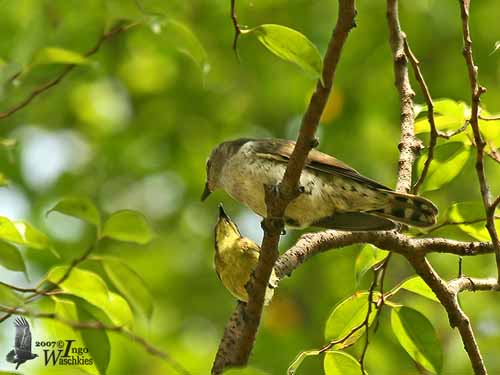
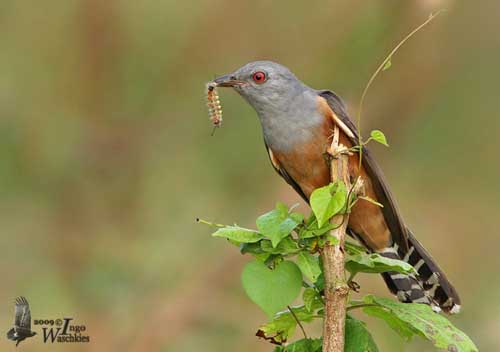
These species are brood-parasitic cuckoos which lay their eggs in nests of other bird species. Before the laying, the female cuckoo which usually has cryptic plumage, detects and observes the future hosts, and may also visit the nest. While the hosts are away from the nest for feeding, the female cuckoo lays her egg into their nest and often leaves it with a host’s egg in the bill. She will eat this egg later. Usually, the cuckoo’s eggs are very similar to those of the chosen hosts.
Later, when the young cuckoo hatches, it rejects the host’s eggs or chicks from the nest, and monopolises the parent care and the food. It grows rapidly but it still depends on its foster parents for several days or weeks after hatching, from 17-20 days to 50-60 days.
Little Bronze Cuckoo
Fed by a Golden-bellied Gerygone
The subfamily Phaenicophaeinae includes two tribes, Phaenicophaeini and Couini. All these species are nest-building, non-parasitic cuckoos of the Old World tropics, and they are mainly found in Southern Asia for the malkohas and in Madagascar for the couas.
The malkohas frequent primary forest and secondary growth, scrub and bushes, forest edge, plantations, mangroves, grassland with bushes, gardens… They may occur from lowlands to high elevation according to the range. They are mainly insect-eaters. They take numerous large insects’ species, caterpillars and spiders. They may consume tree-frogs and lizards, crustaceans and worms.
The malkohas nest in trees. They build a shallow saucer or a small platform of twigs, lined with green leaves. The female lays 2-3 chalky white or creamy-white eggs. Both sexes incubate but the period is unknown.
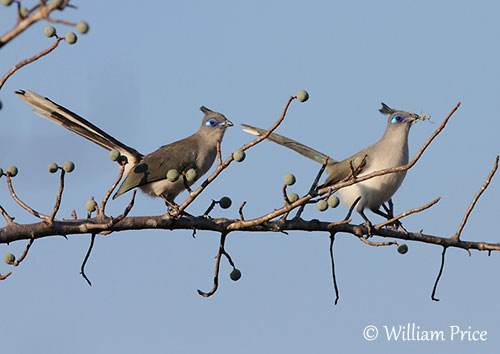
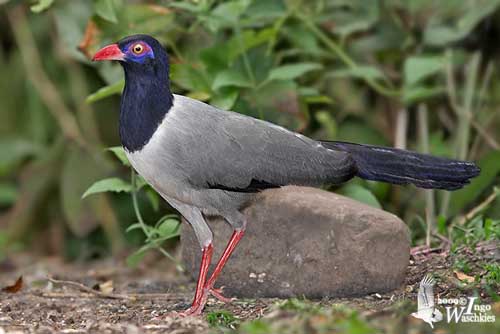
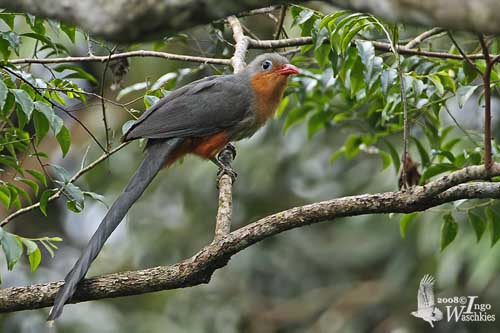
The three ground-cuckoos of genus Carpococcyx from Sumatra, Borneo and Annam, are mainly terrestrial in their foraging and feeding habits. They are resident in lowland and hill forests, and visible from lowlands up to 900/1400/1700 metres of elevation. The ground-cuckoos also take fruit, small reptiles, small mammals and small birds. They nest in trees.
The couas, endemic species to Madagascar, frequent dry and humid forests, thorn scrub and bush, spiny desert, gallery forest on rivers’ edges, savannahs and mangroves. They occur from sea-level to medium and high elevation. They are terrestrial birds. They feed on insects, but spiders, berries, fruits and seeds are also taken.
The couas also nest in trees. Both adults build a bowl of twigs, bark and large leaves, dry stalks, palm fibres and rootlets according to the materials found in the surroundings. The bowl is lined with fine vegetation. It is usually placed between one and ten metres above the ground, in tree or bush. The female lays 2-3 dull white eggs.
The Subfamily Centropodinae includes 28-30 species (coucals) of the unique genus Centropus. These birds are nest-building, non-parasitic cuckoos. They are the largest of the family with a length of 40-68 centimetres.
They frequent a wide variety of habitats such as lower montane rainforest, mangroves, thickets, bamboo and palm vegetation, primary and secondary forests, forest edges, scrub, dense jungle, and they occur generally in thick vegetated areas of all types. They also frequent wet areas, as well mangroves and swamp forest, as ricefields, marshy reedbeds and grass, flooded grasslands, savannahs near water and dense riverine bush.
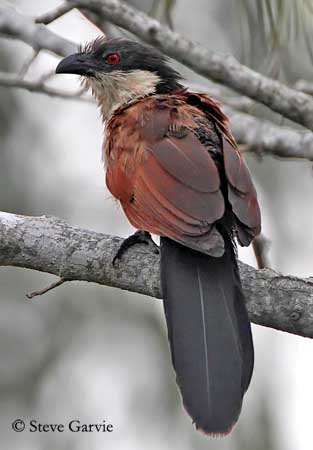
These heavy-bodied birds feed on large insects of numerous species, including large stick-insects (Phasmatodea), spiders, and also small invertebrates such as lizards, snakes, frogs, small birds and mammals.
During the breeding season, the coucals build large nests. These structures can be globular or domed with grass. They are often placed near the ground in tall grass and bushes. There is a side entrance.
The eggs are white and the female lay 2-3 eggs. Both sexes raise the young.
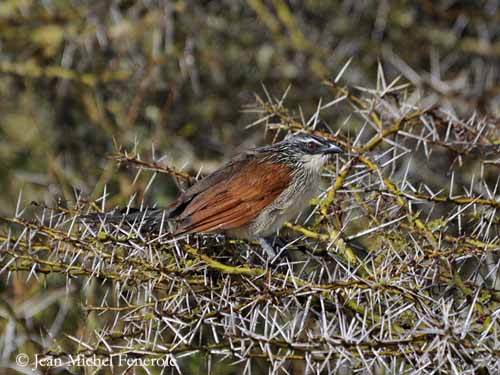
The subfamily Coccyzinae includes 18-20 species of American cuckoos gathered in four genera: Coccyzus, Saurothera, Hyetornis and Piaya. Both genera Saurothera and Hyetornis are now included into Coccyzus.
They are nest-building, non-parasitic cuckoos. They are mainly arboreal species.
They frequent tropical lowland evergreen forest and tropical deciduous forest according to the species. They are usually found in wooded and forested areas such as gallery forest, secondary forest, open or scrubby woodland, shrubby pastures or with scattered trees. They may be found in humid areas, mangroves, swamps, humid woodland edges, forest with seasonal flooding, low thickets and dense shrub near water.
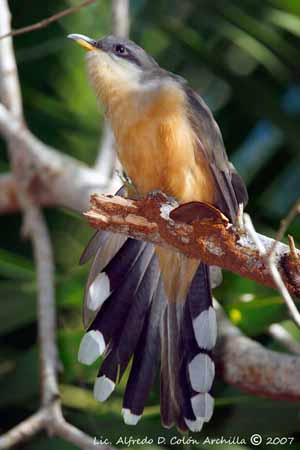
They are insect-eaters, and also feed on caterpillars, but more rarely on frogs, fish and bird’s eggs. Fruit and berries are often consumed in summer and autumn. They also take spiders, snails and lizards. However, their diet varies depending on the range.
Two species, the Black-billed Cuckoo and the Yellow-billed Cuckoo may occasionally lay in nests of other bird species.
But usually, the Coccyzinae species build a flat platform of twigs and vines or leaves, or a shallow saucer of sticks and green leaves.

The Little Cuckoo builds an open, deep cup with twigs. Such nests are placed in thick vegetation or in trees or bushes at variable heights.
The female lays 2-3/3-5 pale or white eggs. The incubation is often shared by both parents and lasts about 10-11 days in Coccyzus, and up to 18 days in Piaya. The young are fed by both adults and fledge between 12-14 and 18-20 days according to the species.
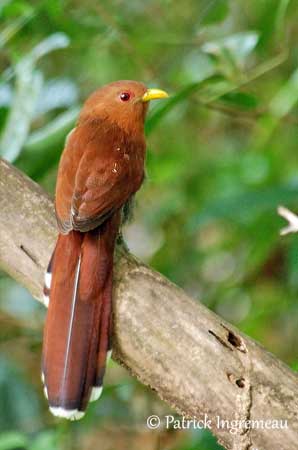
The subfamily Crotophaginae is the smallest with only two genera and four species.
The genus Crotophaga includes the three species anis, and the genus Guira has only one species, the Guira Cuckoo.
All are nesting, group-living cuckoos. They perform co-operative breeding and are often seen in small groups.
The Greater Ani and the Smooth-billed Ani from South America, frequent forested and wooded areas along rivers and occur generally near water. They are usually found in thick vegetation. The Groove-billed Ani prefers drier shrubby areas, thickets, pastures, marshes, cleared and disturbed areas from tropical evergreen forest to tropical scrub.

The Guira Cuckoo occurs in drier habitats such as second growth scrub, savannah with trees and scrubs, pampas, pastures and coastal dunes.
They feed on large insects of various species, caterpillars, spiders, small lizards, frogs, nestling birds and eggs, and also take fruit, berries and euphorbia seeds.
These species are co-operative breeders. They live in groups and the nest is used by more than one female. In Crotophaga, they nest in loose colonies, and the territory is defended by the groups against the other groups.
The adults are socially monogamous, and each female is attended by her mate. They lay in the same bulky nest of sticks and green leaves, placed in branches of trees.
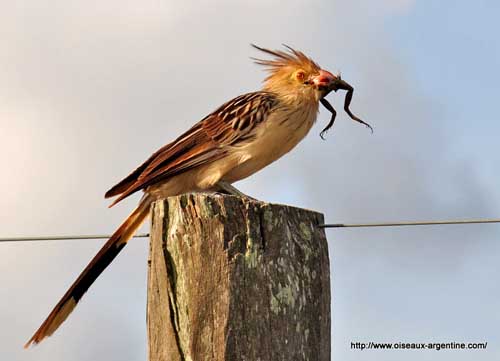
The Guira Cuckoos breed together and have communal nest, but competition and conflicts occur between breeding adults. The females lay in the same nest, but each female is able to recognize her own eggs and she cares them. Several eggs are lost, removed or dropped by adults, probably during the laying or the incubation. The nest is a large open platform of sticks high in thorny tree.
The Guira Cuckoo may sometimes lay in other nests, including of anis, and they may incubate together.
And finally, the subfamily Neomorphinae includes the New World ground-cuckoos.
These long-legged and long-tailed cuckoos have variable breeding habits. Three of them are brood-parasitic species, the Striped Cuckoo, and the two species of genus Dromococcyx, the Pheasant Cuckoo and the Pavonine Cuckoo.
The other species are nest-building, non-parasitic cuckoos.
The roadrunners of semi-arid regions of North and Central America are mainly lizard-catching birds, but they also take grasshoppers and small mammals.
The ground-cuckoos frequent forested and wooded areas. They feed on large insects, frogs, lizards, spiders, and occasionally fruits and seeds.
The Geococcyx species are mainly found in arid scrub, lowland or montane. They frequent dry open country with scattered bushes and several cacti species and thorn scrub. They feed on a wide variety of preys such as large insects, spiders, lizards, snakes, small birds and eggs, mice and other small mammals, young rabbits, fallen bats and roadside carrion. They sometimes consume fruits and seeds.
Both species of genus Dromococcyx frequent tropical lowland forest and seasonally flooded forest and edges. They feed on large insects and lizards taken from the ground.
The Stripped Cuckoo is the smallest of this subfamily. This species frequents the open country with scattered trees, low seasonally wet grasslands, clearing in forest, brush at tropical forest edge and roadsides. It feeds on large insects and caterpillars, and forages alone on the ground.
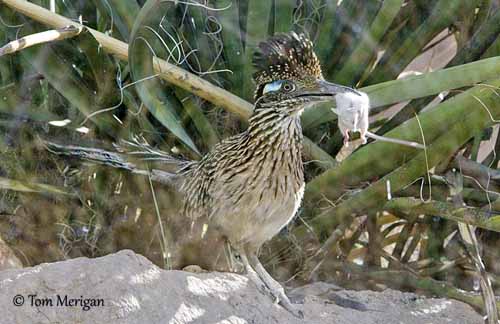
Except the Tapera and Dromococcyx species which parasitize small birds’ nests, and often closed or domed nests, the other Neomorphinae build a nest.
Both roadrunners build an open bulky platform of sticks, lined with leaves, snakeskins and debris. It is placed in bush or low tree.
The breeding behaviour of the Neomorphus species is poorly known. The nest is a broad shallow bowl of sticks, lined with green leaves and placed in dense swampy vegetation.
